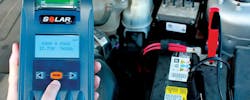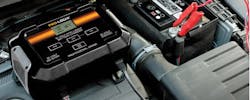Guest Blog: How to service AGM batteries
For many of you, the AGM battery is a familiar item. Perhaps you have a bass boat with an Odyssey battery powering your trolling motor or a vintage car equipped with an Optima battery. If this is the case, you likely know that these batteries require different equipment when servicing them (sometimes). But for most vehicle and equipment owners, the AGM battery brings more questions than answers and not everyone knows the meaning of AGM. So, we thought we’d take this opportunity to address some of the service implications of AGM batteries, which are becoming more and more prevalent in today’s vehicles.
What is an AGM battery?
First, let’s start by defining what an AGM battery is and why is it becoming increasingly popular in today’s vehicles. The AGM battery (meaning absorbent glass mat) is a modified version of the traditional lead-acid battery, with several construction changes to allow it to deliver improved performance in several areas. These construction changes include the use of thinner lead plates, allowing more plates to be packed into the same battery size, which results in greater power. The thinner lead plates can be used because each plate is wrapped in an absorbent fiberglass mat material, which provides structure to that thin plate, keeps the plates from touching, and creates a medium in which the battery’s electrolyte is suspended. This mat is what gives these batteries their name. Finally, because these batteries do not have liquid electrolyte, or are not “flooded”, they are completely sealed, as opposed to a traditional flooded acid battery with fill caps.
These construction changes result in a battery that is more powerful, more durable, longer-lasting, and better able to handle deeper discharging than a traditional lead-acid battery. This last feature is the reason they have become more popular – their ability to be more deeply discharged without harm has made the AGM battery the battery of choice for vehicles equipped with Stop-Start technology. This technology, as we have all come to experience, turns the engine off with each stop to reduce fuel consumption. Doing so places greater strain on the vehicle’s battery since the vehicle’s systems must remain powered during the stop, and results in the battery getting more heavily discharged more often than happens with traditional system designs. Due to this evolution in vehicle system design, the number of new vehicles manufactured using AGM batteries has increased significantly over the past ten years.
What does this mean for service?
Because the AGM battery features a different construction than traditional lead-acid batteries, there are service implications that result. One of the biggest questions we get from professionals and consumers alike is, “How do I know what type of battery it is?” This is a great question. The good news is that starting around 2010, the battery manufacturers and vehicle OEMs did a better job of labeling these batteries AGM. So, the first place we suggest you check is on the battery label itself. Since these batteries are considerably more expensive than standard lead-acid batteries, their AGM construction is usually highlighted. Second, check the battery model number. Often, it could have a suffix such as -AGM. Lastly, check your vehicle owner’s manual – if the vehicle is specified to have an AGM battery installed, it is often called out there. Also, for shops, check your shop information system. These usually do a good job of identifying the battery type specified for each vehicle.
So now you have identified that the vehicle in question does, in fact, contain an AGM battery. What does this mean for servicing it? Of course, that answer is, “It depends!” We’re not trying to make this harder than it has to be, but it really comes down to what type of service we are talking about, as you’ll see below.
Jump-Starting
When it comes to jump-starting a vehicle with an AGM battery, whether that vehicle is a more traditional design or is equipped with Stop-Start technology, you should proceed as usual. The jump-starting process is essentially augmenting the vehicle’s starting battery (which for some reason is not up to the task of starting the vehicle) with additional battery capacity. It is a DC-DC connection and the jump starter is roughly the same voltage as your vehicle’s starting battery. So, connect as you normally would, following the proper connection procedure, and attempt the jump start. When it comes to jump-starting AGM batteries, it is very straightforward (unlike other service applications).
Charging
AGM batteries are much more sensitive than traditional lead-acid batteries when it comes to charging. This falls into two specific areas: the requirements of the overall charging approach/routine and sensitivity to voltage. Traditional lead-acid batteries are very forgiving and can take a multitude of charging approaches and keep on ticking. Not so with AGM batteries, which want a very specific approach and sequence when it comes to charging. They want a constant current bulk charging phase followed by a constant voltage absorption phase, just like what we deliver with our PRO-LOGIX charging approach. In addition, because they are sealed, they are very sensitive to voltage. For batteries, voltage equals pressure. Since the sealed AGM battery has no means to dissipate pressure, voltages must be precisely managed to avoid over pressuring the battery, which can result in degradation of the plates, which eventually will mean that they can no longer hold a charge. So, when charging an AGM battery, it is critical that you use a charger that is specifically designed for use on AGM batteries. This can mean that it is designated “safe” for AGM batteries or, better yet, has a specific charge setting for AGM batteries, as our PRO-LOGIX chargers do. The good news is that these chargers will charge your traditional lead-acid batteries better as well.
Testing
When it comes to testing, it is important to distinguish between digital testing and invasive testing. We’ll get invasive testing (testing with a traditional fixed load or variable load carbon pile tester) out of the way first. For invasive testing, like jump-starting, test the AGM battery as you would test a traditional flooded battery. We recommend using the BCI standard or the specific standard recommended by the equipment the battery is installed in. For digital testing, like charging, it is critical that you use a battery tester that has a specific testing routine for AGM batteries. Preferably, it should have testing routines for the different AGM batteries you will encounter. For instance, our SOLAR BA Series digital testers have specific testing routines for Flat Plate AGM batteries (shaped like a traditional battery) and Spiral Wound AGM batteries. This is because the different AGM constructions behave differently when tested, so, an accurate analysis requires that we have different testing routines for each AGM battery construction.
We get a lot of questions related to this topic and there are many trade publication articles related to it, which tells us that there remains a great deal of confusion when it comes to AGM batteries. We hope that this review of the service implications of AGM batteries helps to reduce some of the confusion and allows you to be more effective and confident when it comes to AGM service.
Information provided by Clore Automotive
About the Author

Jim O' Hara
Clore Automotive
Jim O'Hara has over 15 years experience in the Tool and Equipment industry, including 10+ years at Clore Automotive. At Clore, he heads up the marketing team and is directly involved in the development of new products and enhancements of existing products.

